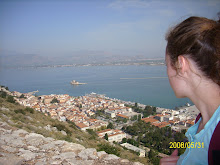Young-Hae Chang Heavy Industries is made up of Young-hae Chang, a Korean artist with a Ph.D. in aesthetics from the University of Paris, and Marc Voge, an American poet based in Seoul. They use the Wed animation tool Flash to create fast-paced text movies set to music.
Bust Down the Doors! (2000) is the story of a midnight raid on a home by unidentified armed intruders. The point of view changes several times between the intruders and the homeowners and a narrator.
This sounds simple but I watched the flash movie and the more the point of view changed the more confusing it became. I was left wondering who the intruders were and who the homeowners were and if they were connected some how. I could watch the video all day to try and figure it out but I don't know if there is anything to figure out. At one point in the movie the perspective is form the narrator and all of the pronouns are you or your making me think that the intruder and the homeowner are the same person. In different versions of the story, the intruders are "you," "they," "we," "I"and the homeowner(s) are "you," "they," "he," "she." The video is very simple because it is just black text flashing across a white screen to the sound of music. The story is also simple because only the pronouns change to change the perspective, but this simple change makes the story seem very complex and mysterious. All other aspects of the story remain the same, such as the phrase that the neighbors yell "Kill the traitor(s)!" The intruders are capturing traiters in their parspective but the homeowners also know that they are traiters when the story is from their perspective. Although it appears very simple, Bust Down the Doors! really makes you think about the story long after you have closed the movie window.
Bust Down the Door Again! Gates of Hell-Victoria Version (2004), is a remix of the original. In this version, the text is red and superimposed over a picture of the work as it was displayed on nine Internet refrigerators for an exhibition in the Rodin Gallery at the Samsung Museum of Art in Seoul. They said, "Advertisers would have us believe that the Internet refrigerator puts the housewife at the cutting-edge of modern, hi-tech life. We titled our piece The Gates of Hell because, on the contrary, we feel that their refrigerator helps keep women in the kitchen."
The text is set to music and is read by a computerized sounding female voice. The words flash one at a time and the story is always from the woman's point of view. This completely changes the meaning of the movie because it gives it more context. The computerized sound of the voice expresses the repetition and monotony of the housewife's life. The "Internet refirgierator" makes her role even more boring. Now, she does not even have to leave the house. The new, cutting edge technology is meant to make her life easier, but it also takes away part of her role and traps her in the house. The story has new meaning after looking at the context and ideas of the work. Is the housewife a "traitor" because she has rejected this new technology or has she grown tired of her unexciting life as a housewife and done something to defy her role? Are the neighbors other housewives who have accepted the technology? Is the intruder actually her husband? Why is she a traitor? I think it might have something to do with the dream about her "lover" mentioned at the end of the story...
While most digital artwork requires or encourages interaction from viewers, Young Hae-Chang Heavy Industries' work only requires that we watch it like a movie. The fast pace of the movies and the elements of mystery and violence force the viewer to concentrate and pay close attention to the movies, wondering what is really happening and thinking about the real meanings and messages of the movies.
Source: New Media Art


No comments:
Post a Comment